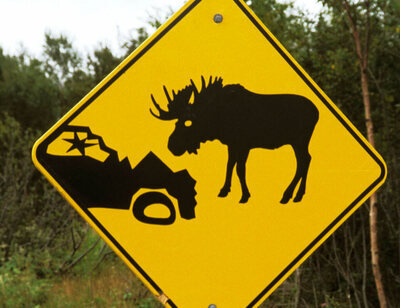Moose
 A visitor to Newfoundland might easily be led to believe that the moose is the provincial animal.
A visitor to Newfoundland might easily be led to believe that the moose is the provincial animal.During our recent visit to Newfoundland, my wife and I could not help but notice that the gift shops are full of moose-related souvenirs. We saw a moose moosaic in a mooseum. Some towns advertise amoosement parks and live moosic concerts. We found these quite amoosing.
All this seemed in curious contrast to all the highway signs constantly reminding drivers to be on the lookout for moose on the roads. Some signs indicated how many road accidents involving collisions with moose have occurred over the last couple of years. We saw a number of moose grazing along the roadsides as we drove. Make no moostake—they are there and I don’t mean mooschief!
Moose are not a native species. Four moose were imported to Newfoundland in 1904. There are now thousands across the province, eating so much that they are creating ‘moose meadows’ in the middle of forests.
The word moose came to English in 1606 from an Algonquian language, likely Narragansett or Abenaki moz from moosu (he strips off; i.e., the stripping of tree bark for winter food). The Penobscot word muns, Ojibwa mooz, and Delaware /mo:s/ also mean moose. The Proto-Algonquian form was mo·swa.
The animals which officially symbolize Newfoundland and Labrador are the Labrador Retriever, the Newfoundland dog, and the Newfoundland pony.
The cariboo, an animal native to Newfoundland, is also an important symbol. The cariboo can be found on the cap badge of the Royal Newfoundland Regiment which was almost annihilated on 1 July 1916 at Beaumont-Hamel during the Battle of the Somme. Of the 780 men who went forward that morning only about 110 survived unscathed, of whom only 68 were available for roll call the following day. The Beaumont-Hamel Newfoundland Memorial in France is marked by a massive sculpture of a cariboo.
Reference: Online Etymological Dictionary, https://www.etymonline.com/
Published on August 31, 2022 21:36
No comments have been added yet.



